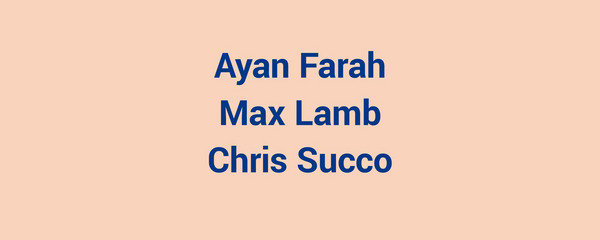Group Show
dal 12/1/2015 al 20/2/2015
Segnalato da
12/1/2015
Group Show
Galerie Almine Rech, London
For the exhibition Chris Succo presents newest canvases. Working with fabric and a variety of natural and man-made materials Ayan Farah creates paintings that evade straightforward categorization. Using artisanal techniques, Max Lamb's process brings forth experimentation with form and natural material.

Despite being on the early side of their careers, Ayan Farah, Chris Succo, and Max Lamb (born 1978, ’79, and ’80 respectively) fill Almine Rech’s London gallery with a surprising amount of history.
Chris Succo, a German artist, paints with a roughness gleaned from a youth spent on the road, and a softness, like the coo of Neil Young lyrics or the lines of poetry that title his paintings (YOU LOOK LIKE NIRVANA JUST BROKE UP, one quips). Succo is indulgent, even belligerent, in his application of paint, and this attitude—in which process, and a passion for the basic tactility of painting—trumps all other concerns. Channeling the personal evolution that Christopher Wool brought to painting, Succo’s newest canvases are an extension of his previous series, riffing off his signature “White Paintings,” in which spray-painted pigment shines through gestural layers of thick, white oil paint. This time, delicate markings recalling handwriting, heartbeats, or meandering scribbles à la Twombly appear on flat, further reduced canvases. There’s less gesture, and no brushstrokes, but every bit of the attitude of an artist who, during talk of oil paint, serigraphy, and his first solo show with Almine Rech Gallery in April, has a telltale longing for long hours in his studio—with no signs of slowing down.
Ayan Farah, who studied with Succo at the Royal College of Art, was born in United Arab Emirates and raised in Sweden, where her mother’s collection of bottled sand and rainwater—gifts sent by family who’d taken meccas to the Holy Land—would one day inspire canvases stained by mud, clay, and water collected from all over the world. A few years ago, lured by an Icelandic volcano teetering on eruption, Farah traveled to the site, leaving her sleeping bag liner buried for a six month stint beneath the ash—and ultimately, articulating a desire to make records of time and place. The following year, Farah returned to Iceland for the first of many pilgrimages to collect earthen materials the world over. Her sources are never random: Farah targets countries mixing paganism with religion, communities praying for rain, or places using cloud seeding to arouse rainfall. For her newest works, she’s scavenged high copper well water from Erigavo, Somalia (her mother’s hometown), mud from the Dead Sea in Israel (for its high salt content), and clay culled from between glaciers in Iceland—all which so beautifully inflict her patchwork canvases with the stained, sewn-together memories of a landscape.
And while Farah once burrowed her sleeping bag beneath a volcano, Max Lamb, a British designer who grew up sculpting sandcastles on the beaches of Cornwall, has continued to make his name casting furniture in cavities of earth, using a primitive method of sand-casting he began during school (he, too, went to RCA). Once native to the Arcadian, albeit isolated countryside of England, Lamb is tirelessly inspired by his landscape, seeking materials from far-flung locations like the brightly colored volcanic rock he sources from Iceland, or the granite he cut from a quarry near Beijing. Lamb’s bronze pieces—like the armchair and bookshelf that reside with Succo and Farah’s paintings—find their genesis in sand. After hand-carving a form from a block of polystyrene foam, Lamb buries his mold beneath the sand and fills it with fiery molten metal. What emerges—a one-of-a-kind, solid bronze replica—bears the pebbled texture of chiseled polystyrene and a modern craftsmanship so uniquely Max Lamb.
'Molly Gottschalk'
Image: invitation
Opening: Tue Jan 13 8pm - 8pm
Galerie Almine Rech
11 Savile Row
Tue - Sat 11am to 7pm



